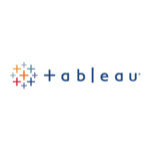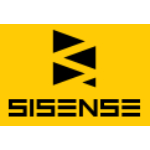TechnologyCounter provides genuine, unbiased real user reviews to help buyers make informed decisions. We may earn a referral fee when you purchase through our links, at no extra cost to you.
List of 15 Best Embedded Analytics Software
Showing 1 - 15 of 16 productsthe world of Tableau, a powerful data visualization software that allows you to analyze, explore, and share insights with ease. With its user-friendly interface features, Tableau simplifies the process of transforming data into meaningful visualizati...Read Tableau Reviews
Looker is a software designed to transform the way you analyze and visualize data. With its intuitive interface and powerful features, Looker is a tool for gaining valuable insights and making data-driven decisions. Get ready to elevate your analytic...Read Looker Reviews
Sisense is a data analytics platform that empowers businesses to make data-driven decisions. Designed with user-friendliness in mind, Sisense allows companies to easily access, analyze, and visualize complex data. With its advanced technology and fle...Read Sisense Reviews
Yellowfin BI is a business intelligence software that helps organizations make better informed decisions through data-driven insights. With its advanced features and user-friendly interface, Yellowfin BI empowers businesses of all sizes and industrie...Read Yellowfin BI Reviews
QlikView is a business intelligence platform that provides users with real-time insights and data visualization capabilities. It allows organizations to quickly analyze and understand their data, enabling them to make informed decisions and drive bus...Read QlikView Reviews
Dundas BI is a business intelligence platform designed to help businesses of all sizes make data-driven decisions. With its intuitive user interface and customizable dashboards, Dundas BI makes it easy to analyze and visualize complex data, empowerin...Read Dundas BI Reviews
TIBCO Jaspersoft is a and innovative business intelligence platform that provides organizations with the tools to visualize and analyze data in order to make informed decisions and drive growth. With its user-friendly interface and robust features, J...Read TIBCO Jaspersoft Reviews
ThoughtSpot is a data analysis platform that helps businesses of all sizes make informed, data-driven decisions. With its intuitive interface features, ThoughtSpot simplifies the way data is analyzed and empowers users to quickly uncover valuable ins...Read ThoughtSpot Reviews
Pi Analytics the all-in-one data analytics solution for your business. With its user-friendly interface features, Pi Analytics empowers you to make informed decisions and drive growth. Whether youre a small startup or a large corporation, Pi Analytic...Read Pi Analytics Reviews
Toucan Toco is the innovative and user-friendly software that is transforming the world of data visualization. With its intuitive interface and powerful capabilities, Toucan Toco empowers businesses to easily create dynamic and insightful reports, br...Read Toucan Toco Reviews
Robo-commodity, a revolutionary software designed to simplify and enhance commodity trading. With its advanced algorithms and user-friendly features, Robo-commodity streamlines the trading process, making it more efficient and profitable for users. S...Read Robo-commodity Reviews
BIRD Analytics is a data analysis tool that takes your business intelligence to new heights. With BIRD Analytics, you can effortlessly access, analyze, and visualize your data in real-time, empowering you to make informed decisions and drive your org...Read BIRD Analytics Reviews
Dotnet Report Builder, the ultimate tool for data exploration and visualization. With its user-friendly interface features, creating custom reports has never been easier. Boost your productivity and make informed decisions with Dotnet Report Builder...Read dotnet report builder Reviews
Qualetics is a software that offers powerful data analysis and visualization tools for businesses of all sizes. With its intuitive interface features, Qualetics empowers organizations to make informed decisions, identify valuable insights, and drive...Read Qualetics Reviews
AirSlate, revolutionizing business processes with its innovative platform. Streamline document management, automate workflows, and collaborate seamlessly with teams. Simplify complex tasks and boost productivity with AirSlates user-friendly and custo...Read airSlate Reviews
- What Is Embedded Analytics Software?
- Top Reasons Why Businesses Need Embedded Analytics Software?
- What Are the Top Key Features of Embedded Analytics Software?
- What Are the Top Benefits of Embedded Analytics Software?
- What Are the Steps to Choose the Right Embedded Analytics Software?
- What Are the Types of Embedded Analytics Software for Different Industries?
- What Are the Technology Trends for Best Embedded Analytics Software?
- What Are the Deployment Options for Embedded Analytics Software?
What Is Embedded Analytics Software?
Embedded analytics software refers to a specific kind of analytics application that is designed to evaluate data derived from diverse sources. The software has a user-friendly interface that enables individuals with less experience to efficiently navigate and examine data.
Additionally, this platform enables customers to generate personalized visual representations or reports derived from the data, which can be seamlessly integrated into their respective websites or systems.
Embedded analytics tools enable firms to enhance their data analysis capabilities, facilitating the development of more profound insights into many aspects such as consumer behavior, customer experience, and product performance, while expediting the analytical process.
Furthermore, it facilitates the automation of decision-making processes through the utilization of data-driven approaches. Facilitating the availability of data in a user-friendly format, it simplifies the process for enterprises to leverage possibilities and enhance their performance and overall expansion.
Moreover, the integration of embedded analytics facilitates the transformation of enterprises into data-centric entities, enabling them to maintain a competitive edge in the dynamic contemporary landscape.
Top Reasons Why Businesses Need Embedded Analytics Software?
1. Increased Efficiency - Embedded analytics software is a valuable tool for organizations as it enhances operational efficiency by offering an enhanced understanding of customer behavior and preferences. This, in turn, enables businesses to make more informed and strategic decisions.
2. Cost Savings - Embedded analytics software aids in the mitigation of expenses linked to manual data processing and analysis by expediting the data collection and analysis processes.
3. Improved Decision-Making - Embedded analytics software offers enhanced capabilities for analyzing client behavior, so enabling businesses to obtain more precise and reliable data. This, in turn, empowers organizations to make more informed and effective decisions.
4. Improved Customer Experience - This offers customers personalized experiences by leveraging their historical behavior and preferences, thereby enhancing the entire customer experience in a good manner.
5. Improved Reporting - The utilization of the best-embedded analytics tools facilitates the optimization of the report-generating procedure, enabling firms to obtain reports that are more precise and comprehensive within a reduced timeframe, and with a diminished occurrence of inaccuracies.
6. Enhanced Security - It enhances data security and mitigates the risk of unauthorized access by implementing advanced data encryption techniques.
7. Greater Visibility - The utilization of embedded analytics software enhances the visibility of both short-term and long-term data, empowering firms to identify and capitalize on opportunities ahead of their competition.
8. Detects Trends - Embedded analytics software enables organizations to efficiently identify patterns and subsequently make informed decisions based on these findings. Through the examination of consumer behavior, embedded analytics software facilitates the ability of businesses to anticipate the requirements of customers and maintain a competitive advantage.
9. Scalability - Best embedded analytics software offers organizations the ability to expand their services in tandem with their evolving needs, hence presenting a cost-effective option suitable for various budgetary constraints.
10. Automated Analysis - Embedded analytics software streamlines the analytical process, so alleviating the manual burden on firms and consequently expediting the decision-making process.
11. Improved Customer Insights - Best embedded analytics tools offer organizations valuable insights into client behavior, enabling them to enhance the precision of their marketing messages and increase customer engagement.
12. Increased Productivity - Embedded analytics software has the potential to enhance productivity and optimize resource allocation by lowering the time required for data processing.
13. Improved Forecasting - Embedded analytics software facilitates the prediction of future trends through the provision of comprehensive data pertaining to historical and current client behavior.
14. Streamlined Data Management - Embedded analytics tools enhance data organization by offering efficient tools, facilitating data tracking and centralization, thereby enhancing overall process efficiency.
15. Increased Insights - Embedded analytics software offers comprehensive analysis of customer behavior, enabling organizations to enhance their products and services in alignment with customer requirements.
What Are the Top Key Features of Embedded Analytics Software?
The top key features of embedded analytics software include:
1. High scalability: The platform offers a range of scalability options that enable rapid adaptation to evolving user requirements.
2. Data visualization: This allows consumers to rapidly and easily visualize data and make informed decisions.
3. Security: Security procedures are used to guarantee the protection and integrity of sensitive information, hence ensuring its confidentiality and security.
4. Flexible deployment: Embedded analytics tools has the capability to be implemented either on-premise or in the cloud, depending on the particular needs and demands of a business.
5. Integrations: The inclusion of robust integrations enables users to conveniently retrieve and present data from many origins.
6. Automation: Automation plays a pivotal role in enhancing the efficiency of data extraction and analysis procedures.
7. Customization: The software for embedded analytics has the capability to be tailored in order to fulfill the specific requirements of each user.
8. Reporting capabilities: The system will generate reports by utilizing user input, hence facilitating the provision of real-time insights. Mobile access allows individuals to conveniently access and engage with data at any given time and location.
10. Dashboards: Developing interactive dashboards is a valuable approach for acquiring insights and comprehending data trends.
What Are the Top Benefits of Embedded Analytics Software?
1. Improved Decision Making: Embedded analytics software offers firms the capability to obtain timely and data-based insights, facilitating prompt and effective decision-making processes.
2. Cost Savings: The implementation of embedded analytics software obviates the necessity for numerous expensive conventional hardware and software systems, hence leading to financial savings.
3. Faster Insights: Embedded analytics software facilitates expedited decision-making for businesses by leveraging a rich and dynamic dataset, hence enabling prompt access to answers.
4. Accessibility: The availability of the best embedded analytics tools facilitates convenient access for businesses to obtain the necessary insights from any device and location.
5. Accurate Results: Embedded analytics software offers enhanced precision in generating results as compared to conventional methodologies, hence guaranteeing outcomes of greater dependability.
6. Scalability: The scalability of top embedded analytics software enables firms to efficiently adjust the program to meet their evolving needs.
7. Advanced Visualization: Embedded analytics software facilitates the visualization and comprehension of intricate data sets, hence enhancing organizations' capacity to analyze the data more effectively.
8. Security: Embedded analytics software offers enhanced security measures compared to standard software, thereby fortifying enterprises against potential data breaches and various cyber-attacks.
What Are the Steps to Choose the Right Embedded Analytics Software?
1. Identify the software: There exist three primary categories of software, namely dashboarding solutions, business intelligence (BI) platforms, and analytics modules. The many solutions available can fulfill distinct objectives based on the specific requirements of data analysis and reporting.
2. Estimate the performance requirements: Prior to making a software selection, it is imperative to ascertain the level of performance required from the system. This procedure will aid in the process of refining and limiting the range of functionalities offered by the different software solutions that are under consideration.
3. Consider the prices: Upon conducting a comprehensive performance evaluation, it is imperative to engage in a comparative analysis of the diverse price models provided by the software solutions that align most effectively with your requirements.
4. Evaluate the usability of the software: The ease of embedding and deploying the solution is a crucial factor to take into account. This analysis aims to assess the level of user-friendliness exhibited by the software, taking into account its various aspects that contribute to enhancing its ease of use.
5. customization options: Numerous software solutions provide customization features that enable users to personalize the solution according to their individual requirements. This may encompass various aspects such as the utilization of data visualization techniques, the creation of dashboards, or the customization of the user interface.
6. Assess customer support: It is imperative to ascertain if the chosen vendor possesses the requisite customer support capabilities. Possible components of this could encompass training, maintenance, and/or installation services.
7. Review the security offered: It is imperative to ensure that the security provided by the solution aligns with the security requirements of the organization. It is imperative to give due consideration to any supplementary steps that may be necessary in order to ensure the security of the data analysis and reporting environment.
By adhering to these procedures, one can proficiently assess the diverse embedded analytics software solutions and identify the most suitable one that aligns with their requirements.
What Are the Types of Embedded Analytics Software for Different Industries?
The specific form of embedded analytics software may exhibit variability contingent upon the particular sector in question. There are various prevalent forms of embedded analytics tools that cater to distinct businesses.
1. Manufacturing: The system analytics software facilitates the tracking of production rates, monitoring of equipment performance, and analysis of data patterns for companies.
2. Financial: The utilization of financial analytics software facilitates the decision-making process for firms in topics pertaining to investments, pricing, and various other financial aspects.
3. Healthcare: The healthcare analytics software facilitates the analysis of medical data, enabling companies to discern patient trends and devise suitable treatment strategies.
4. Retail: Retail analytics software is a technological tool utilized by firms to monitor and analyze customer behavior, enhance pricing strategies and product positioning, and detect patterns and shifts in sales performance.
5. Insurance: The insurance analytics software facilitates the evaluation of claims, detection of fraudulent activities, and integration of risk analytics into the decision-making processes of businesses.
6. Energy: The energy analytics software facilitates the optimization of energy usage and cost reduction for enterprises.
7. Government and Law Enforcement: The utilization of government and law enforcement analytics software facilitates the process of data organization, trend monitoring, and law enforcement for various organizations.
What Are the Technology Trends for Best Embedded Analytics Software?
The prevailing technology developments in the realm of embedded analytics software encompass a range of key aspects, including a heightened emphasis on data security, scalability, analytics governance, seamless integration with cloud infrastructure, utilization of artificial intelligence (AI) and machine learning (ML) techniques, predictive analytics capabilities, and provision of embedded support for mobile devices.
The significance of data security in embedded analytics tools is growing as it heavily relies on the acquisition of confidential data. The implementation of data governance is necessary in order to guarantee the appropriate handling of gathered data and to prevent unauthorized access by harmful entities or organizations.
The consideration of scalability holds significant importance in the context of embedded analytics. As the size of data sets increases, it becomes imperative for analytics to exhibit scalability in order to efficiently and accurately analyze substantial volumes of data.
The attribute of scalability facilitates the utilization of the top embedded analytics software across diverse platforms. Cloud integration facilitates the ability of companies to retrieve and evaluate data from many origins, irrespective of their geographical placement. Enhancing the analytics and insights of a company is crucial for optimizing its performance.
Artificial intelligence (AI) and machine learning (ML) are significant technological advancements that are exerting a notable influence on the field of embedded analytics. Artificial intelligence (AI) and machine learning (ML) have the potential to assist in the identification of latent patterns and emerging trends inside datasets that may otherwise remain undetected.
This approach has the potential to enhance the utilization of an organization's data assets. Embedded analytics relies heavily on the utilization of predictive analytics. Predictive analytics possesses the capability to assist enterprises in proactively anticipating forthcoming trends and events.
Embeddable bi tools have the potential to enhance the process of strategic decision-making and facilitate the identification of novel prospects. The inclusion of embedded support for mobile devices holds significant importance.
With the increasing prevalence of mobile usage, it has become imperative for embedded analytics to possess the capability of delivering insightful information on smaller devices. This guarantees that a business may effectively leverage its data assets, irrespective of the platform or device utilized by the user.
What Are the Deployment Options for Embedded Analytics Software?
The available deployment choices for embedded analytics software encompass on-premise, cloud-based, end-user self-service, and hybrid deployments.
1. On-premise deployments encompass the installation and hosting of analytics software on the customer's infrastructure, typically within a data center.
2. Cloud-based deployments refer to the practice of putting analytics software on a third-party cloud-hosted platform, such as Amazon Web Services (AWS) or Microsoft Azure.
3. The implementation of end-user self-service involves the facilitation of user access and engagement with analytics software within their own applications, including websites or mobile applications.
4. Hybrid deployments encompass a fusion of on-premise, cloud-based, and end-user self-service deployments.















